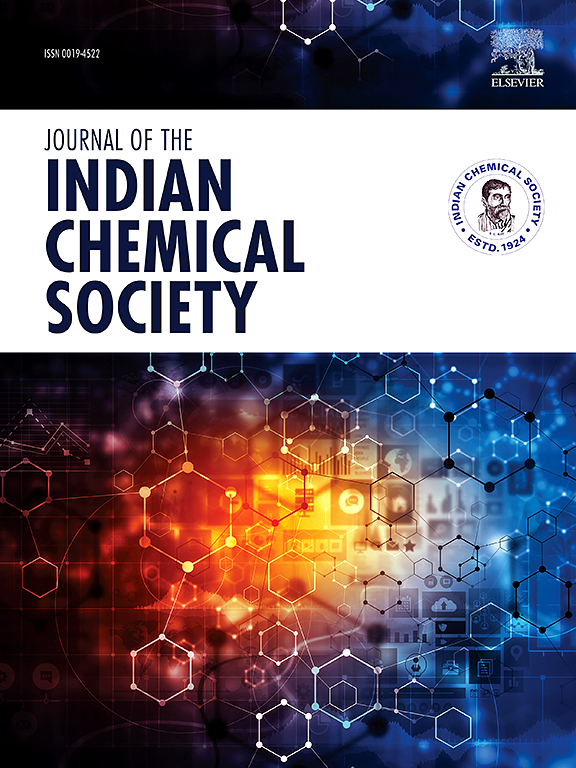1,3-噻唑烷-4-酮基化合物的优化:设计、合成、生物学评价、分子建模和ADME研究
IF 3.2
4区 化学
Q2 CHEMISTRY, MULTIDISCIPLINARY
引用次数: 0
摘要
构造了一系列噻唑烷酮衍生物(5a-f),并通过IR、1H NMR、13C NMR和元素分析对其结构进行了鉴定。对所制备的化合物进行了抗菌和抗氧化活性评价。抗菌筛选结果表明,2-羟基-4-(2-(4-硝基苯基)-4-氧噻唑烷-3-基)苯甲酸(5b)和2-羟基-4-(2-(4-羟基苯基)-4-氧噻唑烷-3-基)苯甲酸(5c)对所有被试细菌(ZI = 29-42 mm;MIC = 75 ~ 128 μg/mL),活性高于氨苄西林(ZI = 26 ~ 30 mm;MIC = 100 ~ 150 μg/mL)。在抗氧化活性方面,噻唑烷酮衍生物5c (IC50 = 20.43 μg/mL)、5e (IC50 = 21.06 μg/mL)和5f (IC50 = 22.18 μg/mL)的抗氧化活性高于参比药抗坏血酸(IC50 = 17.13 μg/mL)。对DNA旋切酶活性位点内的噻唑烷酮衍生物5a-f进行对接研究,试图预测这些化合物的结合模式。所有对接的候选5a-f都记录了高结合分数,与必需氨基酸LYS103形成氢键相互作用和其他疏水结合。此外,还进行了ADME研究,以预测构建的化合物作为口服候选药物的适用性。结果表明,噻唑烷酮衍生物具有良好的抗氧化潜力,是一种很有前景的抗菌药物。本文章由计算机程序翻译,如有差异,请以英文原文为准。

Optimization of 1,3-thiazolidin-4-one based compounds: Design, synthesis, biological evaluation, molecular modeling and ADME studies
A series of thiazolidinone derivatives (5a-f) was constructed and the structure of these compounds was elucidated by IR, 1H NMR, 13C NMR, and elemental analyses. The prepared compounds were assessed for their antimicrobial and antioxidant potential. The obtained results from antimicrobial screening revealed that 2-hydroxy-4-(2-(4-nitrophenyl)-4-oxothiazolidin-3-yl)benzoic acid (5b) and 2-hydroxy-4-(2-(4-hydroxyphenyl)-4-oxothiazolidin-3-yl) benzoic acid (5c) were the most active against all tested bacterial species (ZI = 29–42 mm; MIC = 75–128 μg/mL) and were more active than ampicillin (ZI = 26–30 mm; MIC = 100–150 μg/mL). Regarding antioxidant activity, thiazolidinone derivatives 5c (IC50 = 20.43 μg/mL), 5e (IC50 = 21.06 μg/mL), and 5f (IC50 = 22.18 μg/mL) were the most active compounds in comparison to the reference drug ascorbic acid (IC50 = 17.13 μg/mL). A docking study of the thiazolidinone derivatives 5a-f inside the DNA gyrase active site was conducted in an attempt to predict the binding modes of these compounds. All the docked candidates 5a-f recorded high binding score forming hydrogen bonding interactions and other hydrophobic bindings with the essential amino acid LYS103. In addition, ADME study was conducted to predict suitability of the constructed compounds to be oral drug candidates. The results of this work suggested that thiazolidinone derivatives could be promising antimicrobial agents with considerable antioxidant potential.
求助全文
通过发布文献求助,成功后即可免费获取论文全文。
去求助
来源期刊
CiteScore
3.50
自引率
7.70%
发文量
492
审稿时长
3-8 weeks
期刊介绍:
The Journal of the Indian Chemical Society publishes original, fundamental, theorical, experimental research work of highest quality in all areas of chemistry, biochemistry, medicinal chemistry, electrochemistry, agrochemistry, chemical engineering and technology, food chemistry, environmental chemistry, etc.

 求助内容:
求助内容: 应助结果提醒方式:
应助结果提醒方式:


